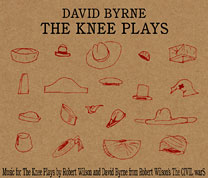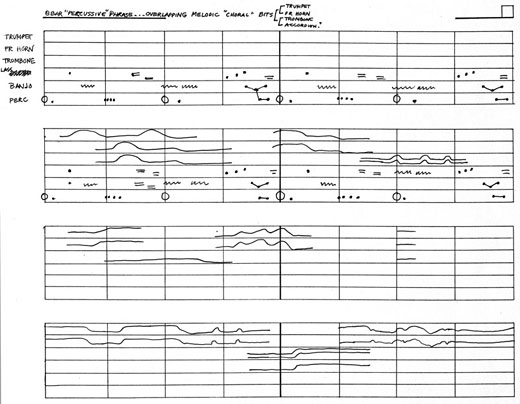THE ALBUM

- ESSAY
- TRACKS, LYRICS, & AUDIO
- CURRENT REVIEWS
- LIVE DATES (COMING SOON)
- CREDITS
- BUY CD (AMAZON.com)
- DOWNLOAD (COMING SOON)

[ + ] POP-UP LARGE




Clockwise from top left:
Brass [ + ] POP-UP LARGE
unknown [ + ] POP-UP LARGE
Tuba [ + ] POP-UP LARGE
Trumbone Hyme [ + ] POP-UP LARGE
WHAT’S A KNEE PLAY
Knowing that in the final production there might be some noisy scene- changing going on during these short plays, I reasoned that the music I created would need to drown out those noises. The music or musicians would also have to be portable—the nature of entr’actes is that they’re usually performed in front of the main curtain—so all our stuff would have to enter and exit swiftly and couldn’t be preset. So, at that time, I tried using percussion instruments—as used in Kabuki and elsewhere—as sound effects and as commentary on the action rather than as “music.” I worked with some traditional Kabuki musicians in a recording studio, and “directed” them by describing imaginary scenes. This was what they were used to as far as musical direction; they didn’t play “music” as we know it in the West, or grooves (although there were occasional dance numbers). I had a few of these same instruments that I could play during rehearsals in the Tokyo warehouse, to see how the sounds complemented the action. It worked OK, but I wasn’t sure.
For me, this was a different definition of music. As I said, the traditional Kabuki form of music doesn’t rely on written melodies, and is perhaps more akin to the work of a foley artist in film post-production, or the sound designer in films such as Hitchcock’s, or the work of Walter Murch on THX 1138 (1971), or the work of contemporary composers using indeterminate scores.
Meanwhile, rehearsals for the other, larger act continued parallel to ours. Bob had enlisted a local Butoh group, who practiced a genre of Japanese avant-garde theater based, sometimes, on traditional movements or attitudes, but updated. They appeared with their genitals squished into swim masks and covered with white powder, which they seemed to manage to spread everywhere.
Adelle suggested adapting the concept used in Bunraku (Japanese puppet theater) whereby the musicians and the storyteller would be present on the stage alongside the actors/dancers. We set ourselves to the problem of how, for starters, to make a tree into a boat on stage as described in Bob’s story. I came up with a not-entirely-original solution. If everything were made of a grid of cubes, with all the shapes abstracted into cube modules, then, like big children’s building blocks (or a Sol Lewitt sculpture in this case), things could be “transformed” by the actors into various objects: trees, boats, or maybe even a bird. (Well, maybe not this last one). Adelle, inspired by Peking Opera, suggested creating the sea by using fabric on poles. Almost all the props could therefore stay flat and portable.
After some sketching it seemed like a promising approach, so we got some cardboard boxes and made rudimentary cubes and began to figure out how this story might be told. It turned out it could be done more as a dance than a naturalistic drama, which suited Bob’s own style perfectly. The performers would use these light hollow cubes as props that would become rudimentary sets.

Graphic musical notation (unused). There were many page like this—each instrument was represented by a bar line and the “shape” and texture of each note, and its relationship to those of the other instruments, was represented by drawn shapes.
Upon returning to New York City, Adelle and I began to research some of the less classic dance styles we’d seen in Japan, as those seemed absolutely to echo the work of the downtown NY crowd. Robyn Brentano at Bob’s office introduced us to Beate Gordon at the Asia Society, and she introduced us to Suzushi Hanayagi, a traditionally trained Japanese dancer who had also worked with Trisha Brown and others at the Judson Church, an early home for some dance and performance art. Beate was adamant that Suzushi would not be offended by what we were doing with Kabuki dance. So, comfortable in both worlds, Suzushi was a perfect fit! It was decided that she would choreograph the Knee Plays when the production went into the next phase of rehearsals in Minneapolis.